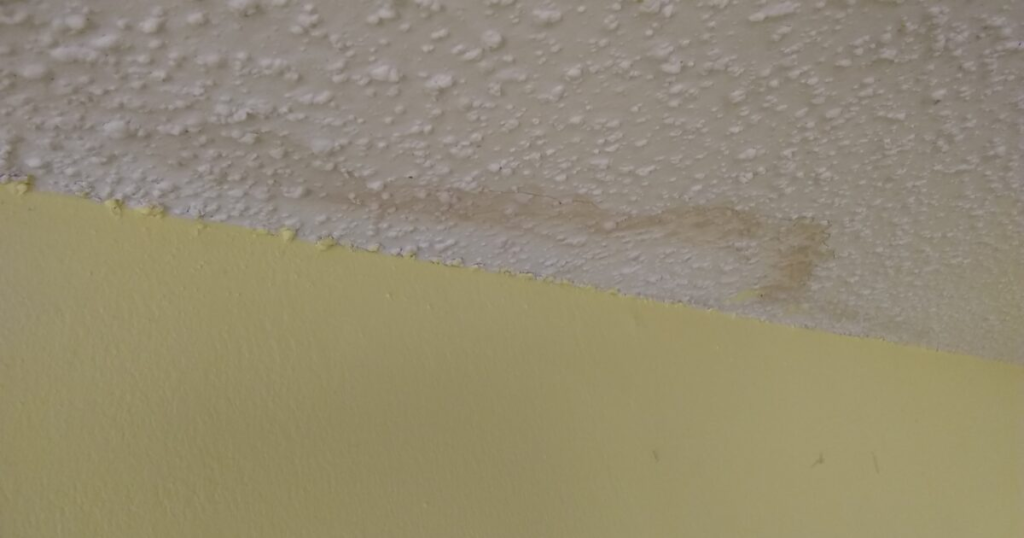Water damage on popcorn ceiling can be a troubling issue for homeowners, leading to unsightly stains, structural issues, and potentially hazardous mold growth. In this comprehensive guide, we delve into the causes of water damage on popcorn ceilings, effective remediation strategies, and essential tips for prevention.

What is Water Damage on Popcorn Ceilings?
Water damage on popcorn ceilings refers to any form of moisture infiltration that compromises the integrity and appearance of the textured surface. Popcorn ceilings, also known as acoustic or stipple ceilings, are characterized by their rough, bumpy texture, which can absorb and retain moisture when exposed to water leaks or high humidity levels.
Causes of Water Damage on Popcorn Ceilings
Plumbing Leaks
One of the most common causes of water damage on popcorn ceilings is plumbing leaks. Leaky pipes, whether from supply lines or drain lines, can release water into ceiling cavities, gradually saturating the popcorn texture and causing it to sag, discolor, or even collapse in severe cases.
Roof Leaks
Roof leaks are another frequent culprit behind water damage on popcorn ceilings. Damaged shingles, improper flashing, or clogged gutters can allow rainwater to seep into the attic space and eventually penetrate through to the ceiling below, compromising the popcorn texture and underlying materials.
Read too: Kitchen Lighting For A Vaulted Ceiling: Illuminating Your Space with Style and Functionality
Condensation
Excessive condensation due to poor ventilation or high humidity levels can also contribute to water damage on popcorn ceilings. When warm, moist air comes into contact with cooler ceiling surfaces, condensation forms, leading to damp spots, staining, and deterioration of the popcorn texture over time.
Bathroom Moisture
In bathrooms, inadequate ventilation during showers or baths can cause moisture to accumulate on popcorn ceilings. This moisture can gradually degrade the texture and create an environment conducive to mold growth, posing health risks and further compromising the ceiling’s structural integrity.
Signs of Water Damage on Popcorn Ceilings
Recognizing the signs of water damage early can help prevent extensive repairs and mitigate potential health hazards. Common indicators include:
- Staining: Discoloration or yellowing spots on the ceiling surface.
- Sagging: Visible bulging or softening of the popcorn texture.
- Peeling or Bubbling: Texture that appears to peel away or form bubbles.
- Musty Odor: Mold or mildew growth often accompanies water damage and emits a distinct musty smell.
Remediation and Repair Options
Assessing the Extent of Damage
Before proceeding with repairs, assess the extent of water damage on your popcorn ceiling. Determine whether the damage is localized or widespread, and identify the source of the water intrusion to prevent future issues.
Repairing Small Areas of Damage
For minor water stains or small areas of popcorn texture damage, consider spot cleaning and patching techniques. Use a stain-blocking primer to cover water stains, and carefully apply new popcorn texture to blend with the existing ceiling.
Removing and Replacing Damaged Areas
In cases of extensive water damage or significant mold growth, it may be necessary to remove and replace sections of the popcorn ceiling. Hire a professional contractor experienced in handling textured ceiling repairs to ensure safe removal and proper installation of new materials.
Addressing Underlying Issues
Address the underlying causes of water damage to prevent future incidents. Repair leaking pipes, fix roof issues, improve ventilation in bathrooms, and consider installing dehumidifiers or exhaust fans to reduce moisture levels.
Prevention Tips for Water Damage on Popcorn Ceilings
Regular Maintenance
Perform routine inspections of your home’s plumbing and roofing systems to detect and repair leaks promptly. Check for signs of water stains or mold growth on ceilings and walls, as these can indicate hidden water damage.
Roof Maintenance
Inspect your roof regularly for damaged or missing shingles, deteriorated flashing, and clogged gutters. Clean gutters and downspouts to ensure proper drainage and prevent water from seeping into the attic and ceilings.
Ventilation Improvement
Improve ventilation in bathrooms, kitchens, and attics to reduce humidity levels and minimize condensation on ceilings. Use exhaust fans during showers or cooking, and consider installing roof vents or ridge vents to promote airflow.
Professional Inspections
Schedule annual inspections with qualified professionals to assess the condition of your home’s plumbing, roofing, and HVAC systems. Address any issues promptly to prevent costly repairs and potential water damage to ceilings and other structural components.
Conclusion
Water damage on popcorn ceilings can compromise the aesthetic appeal, structural integrity, and indoor air quality of your home. By understanding the causes of water damage, recognizing early signs of moisture infiltration, and implementing effective prevention and remediation strategies, you can protect your popcorn ceilings and maintain a safe and comfortable living environment.
Whether you’re dealing with a minor water stain or significant ceiling damage, taking proactive measures and seeking professional assistance when needed will help preserve the beauty and value of your home for years to come.
